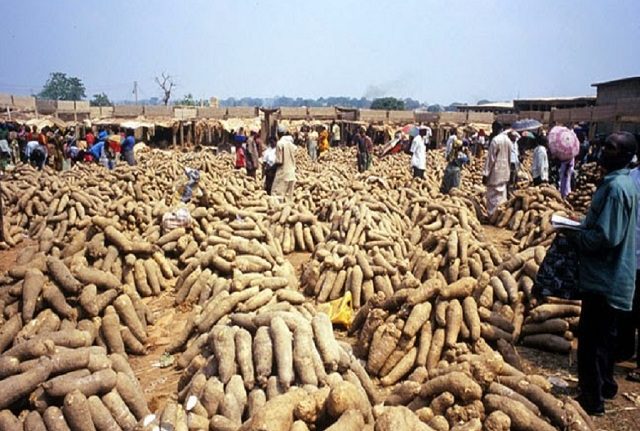Yam export: No cause for worry – FG

Minister of Agriculture and Rural Development, Chief Audu Ogbeh, has reassured Nigerians that there is no reason to be anxious about what the new initiative of the Federal Government on yam export portends for the populace, saying those insinuating possible non-availability of the farm produce for local consumption as a result of the export should discard the idea.
Ogbe, who gave this assurance as a prelude to take off today (Thursday) in Lagos of the country’s yam export to Europe and the United States of America, said: “This week signals a new dawn in Nigeria’s food exports with a consignment of 72 metric tons of yam leaving the shores of Nigeria to Europe and the United States essentially setting the stage for the country’s return to the global yam value chain as a dominant player in the world market which is long overdue.
“Nigeria has consistently been reckoned globally as the largest producer of yams at various times accounting for anything between 65 and 76 per cent of the world production. The Food and Agriculture Organisation (FAO) report, in 1985, reported that Nigeria produced 18.3 million metric tons of yams from 1.5 million hectares, representing 73.8 per cent of total yam production in Africa.
“A report by Fact fish, a research agency, disclosed that, in 2014, an estimated 45,004,340 metric tonnes of yam was produced on 5,416,400 hectares of farmlands at 8,308.9 kilogrammes or 8 metric tonnes per hectare. This was an increase over the 2013 figure estimated at 35,618,420 metric tonnes and 2012 production of 32,318,900 metric tonnes following annual production fluctuations ranging between 26 million MT and 37 million MT from 2001 to 2011”.
The Minister revealed that Ghana, by contrast, is the third largest producer in West Africa after Nigeria and Cote d’Ivoire, producing 11.2 per cent the world total but accounts for over 94 per cent of total yam exports in West Africa with about 90 per cent of its yams exported to the United States, Canada, UK and other European countries.
As a leading exporter of yam, Ogbe said Ghana’s yam export trade employs over one million workforce with the export volume for 2014 which stood at US$18.8 million, while 2013 export figure was about US$15million amidst increases in demand for the commodity in both fresh and processed forms in new markets, both overseas and local.
“Nigeria can do better, he said, adding that the export of Nigeria yams is not new.
He said: “It has been going on rather informally through other ports and largely unaccounted for. Although we have neither been told of any shortage of yams in Nigeria from any of the credible sources nor have we got any reliable statistics of yam production and trade.
“Most statistics on yam production and post-harvest handling and trade have been largely generated from outside official sources apart from those from research-based organisations within and outside Nigeria. Nigeria’s potential in yam value chain still remains to be unlocked, offering enormous opportunities in the future. But these cannot be turned to wealth until business constraints are dealt with, paving way for generation of reliable data to inform appropriate policy interventions.
“The pursuit of green alternative is a departure from mono-cultural economy to diversify our economy; therefore, we need to explore new ways of creating wealth and earning foreign exchange, particularly from commodities in which we have competitive advantages in terms of volume and value. We need to occupy our ecological niche in the emerging global market, in yam and other agro-commodities”.
The Minister emphasised that yams are grown in Nigeria in vast areas of the country covering many agro-ecological zones, from the coastal region in rain forests, wood savannah to southern savannah habitats spreading over all the 36 states of the country.
“Nigeria can leapfrog from that humble earning to substantially higher revenues within a year and overtake Ghana in the short-term and retaining that lead thereafter. To position Nigeria for a leading role in yam export, the government’s intervention will be addressing issues of storage facilities to minimize post-harvest losses and deployment of mechanized methods of yam production in addition to quality assurance.
“With appropriate knowledge, yam value chain presents a range of opportunities for farmers to improve their yields and reduce their post-harvest losses. Nigeria is diversifying the presentation of yam in form of flour, chips and chunks. Investments in the provision of low cost processing equipment that is affordable for small scale processors would encourage existing processors in the landscape and potential yam processors.
“An intervention known as Yam Improvement for Income and Food Security in West Africa (YIIFSWA) appears poised to double incomes from yam through multiplying its production for 3 million smallholders farming families who depend on yam in West Africa and contribute to food security for processors and consumers”.
He pointed that farmer’s productivity and reduction of losses could be guaranteed with the use of appropriate technology with the advancements in improved seeds, adding that it is imperative that these seeds get distributed in a sustainable manner.
The coordinator of YIIFSWA project, Dr. Okechukwu Eke-Okoro, in his contribution said “it is about production of clean and disease free seed yams to strengthen the formal seed yam system in Nigeria”.
He said the restructuring and recapitalisation of the Bank of Agriculture will enable the government to overcome the lack of finance, inadequate farm inputs, storage facilities and high cost of labour identified as the primary constraints to yam production in the country.








